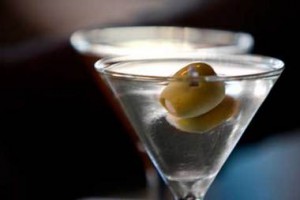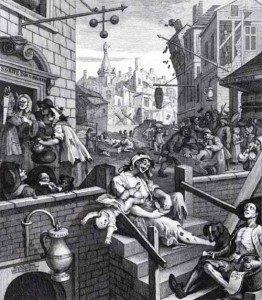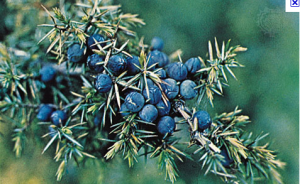
The Classic Gin Martini
Gin is the ultimate flavored Vodka. That title alone should be enough for Gin fans everywhere but for years if not decades we keep hearing that Gin will be the “next” hot spirit. I suggest that Gin never needed widespread appeal as Gin fans are a devoted bunch and in no need of validation from the hip crowd.
However, when all things are considered, Gin is the ideal spirit for our time and all times. It’s well-suited for the cocktail culture that we now enjoy, the category’s newcomers are primarily in the premium arena that satisfies the quality spirits trend, and the subject of Gin is great fodder for analysis and debate.
Gin can be a polarizing drink. Gin drinkers are fiercely loyal to their brand and style of choice but they are conversely open to experimentation. Some enjoy the classic juniper heavy styles while others crave citrus-forward Gins and so on. But Gin drinkers tend to take their opinions beyond advocating for their preferred style by nearly despising opposing styles.
While Bourbon drinkers may prefer a wheat heavy recipe to a rye centric formula, but they tend not to rail against the other. Scotch Whisky lovers may prefer the smoky, peaty drams of Islay but they will cheerfully sip a malty, Sherry infused Speyside with vigor. Gin often forces one to choose sides. However, I am seeing greater flexibility with new Gin drinkers and that’s a good thing.
A Brief History of Gin
In the days when spirits were used exclusively for their medicinal qualities, (wink, wink, nudge, nudge) herbs and spices were steeped in the elixir of choice to cure whatever ailed you. One of the most popular, and reputedly potent, of these spices was the juniper berry.
Juniper tonics gained tremendous popularity in the 14th century when they were used to ward-off the plague and nearly any other discomfort. Juniper concoctions proved useful in treating bladder and kidney aliments, as well as strengthening the immune system.
Somewhere (no one can agree exactly when) along the way these juniper laced tonics became known simply as Genever, the Dutch word for juniper. We do know that there was a written reference to Genever in the 13th century text, Der Naturen Bloeme. In the late 16th century English soldiers fighting with the Dutch in the Eighty Years’ War were praising Genever’s calming properties before battle.
There is no doubt that Gin, or Genever, was a Dutch creation.
Again during the Thirty Years War English mercenaries again fought along side the Dutch and again encountered Gin. It was during this conflict that it is believed that the term “Dutch Courage” was first coined.
The English became further persuaded to partake in all things Dutch when Dutch-born William of Orange seized the English throne from James II (The “Glorious Revolution” of 1688) and soon discouraged the import of brandy from Catholic wine producing nations.
In 1690, the English Parliament determined that all one needed to become a distiller was to post a notice of intent 10 days prior. Soon after the tax on Beer doubled, further promoting Gin as the English drink of choice. In 1730 11 million gallons of Gin were consumed annually rising to 20 million in 1750 (keep in mind that England’s population was just about 7 million)!
Gin became synonymous with drunkenness, slums, and the impoverished working class. The tipple that was once seen as the answer to everything from Black Death to the common cold was now viewed as the root of all evil.
It wasn’t long before Gin was blamed for all of the land’s ills. In 1736 the infamous Gin Act was passed imposing a levy on the spirit that effectively increased the price by a factor of five and limited the purchase of Gin to two gallons at a time.
As you can imagine the new licensing fees and the retail tax were very unpopular, especially with poor, resulting in riots intensifying in 1743. The fees were stepped down a bit but problems with Gin remained resulting in yet another bit of parliamentary magic in the form of the Sale of Spirits Act 1750.

Gin Lane
William Hogarth in his engravings Beer Street and Gin Lane (1751) famously depicted the public perception of Gin versus Beer.
Long-injured in the Gin kerfuffle were England’s brewers resulting in, you guessed it, more intervention from Parliament in the name of the Brewhouse Act of 1830. Sometimes it’s the medicine itself that causes the pain.
Gin’s reputation took many decades to repair, but it did. By the mid 1800s Gin was the fashionable drink-of-choice in London and certainly the desired beverage among America’s elite during the dark days of Prohibition.
Gin’s popularity rose during prohibition as it did not require aging and could go from the production stage to the speakeasy in little time. In the aftermath of Prohibition Gordon’s opened its first distillery in 1934 (the year after repeal) with Gilbey’s coming online in 1938 and Seagram’s in 1939 albeit in Canada.
Creating Gin
Gin, like Vodka or Rum has no requirements regarding its place of origin. All that is required is that it feature its namesake botanical, juniper.
Gin producers have their own set of rules and practices and every one of them is convinced that their method is superior. It’s the great chili cook-off of the spirits world.
Gin is typically made from neutral spirits that are infused with a concoction of botanicals starting with juniper and often including coriander along with any number of herbs and spices such as: ginger, orange peel, cardamom, angelica root, nutmeg, clove, cassia bark, and nearly anything else one could imagine.
The method employed to introduce these herbs and spices into the spirit is another matter of great debate. Most common is the steeping method that can last from hours to days followed by one last distillation that is said to “fix” the flavors to the spirit. Some choose to keep the botanicals in whole form while some prefer to crack and crush the spices to release more intense flavors.

Gin’s Required Botanical – Juniper
Another approach involves suspending a basket of botanicals in the still allowing vapors to pass through extracting aroma and flavor in this way. Those who use this technique exalt its delicate and pure results. In the case of cheap Gins, they use a method known as “cold compounding” where flavor essences are added to the neutral spirit. The results are about as awful as you would imagine.
Of course there are also many approaches to the spirit itself. Most Gins are made with a grain spirit base while a grape (or other fruit) base is certainly popular. Most Gins are crafted in column stills while pot stills are also used and often create Gins with a rich and oily texture.
Gin Styles
When talking Gin styles we have to start with the original, Genever. Genever is semi-viscous being frequently malty and as much about the spirit as it is about the botanicals. This is greatly demonstrated in Oude (old) Genever. Old in this instance is not an indicator of age, but rather the sub-style that accentuates the lush, malty flavors.
The English Gin evolved to a crisp, dry style of London Dry that we are familiar with today. The style’s first divergence from Genever came in the use of column stills that created a lighter, drier spirit than the traditional pot still Genever. London Dry is typically bottled at a slightly high proof to better accentuate the aromatic botanicals.
Another style of English origin is the Plymouth style Gin. This style had been geographically protected meaning that it could only be produced in Plymouth. The first Plymouth Gins were very much like Genever but the style evolved to become more like the London Dry style albeit a little sweeter and fruit-forward.
Sweeter still among the English birthed Gins is the Old Tom style. This style was born in the 18th century and was, and is, more like Genever than London Dry. This was the preferred style in cocktails as it held its own and added a lot of texture to any drink. The style all but died in the 20th century but is now seeing a much needed revival. Today there are dozens of Old Tom Gins available and many of these are worthy of your attention.
Navy Strength Gin is a powerful Gin typically a higher proof version of a London Dry or Plymouth style bottled at 57% abv. The name is derived from the British Naval tradition of having Gin aboard their vessels at all times. Often the casks of Gin where kept near the gunpowder and wet gunpowder won’t fire your canons. However, spirit at 57% abv or higher will ignite and thus the standard was set.
Mahón style Gin is made in the Spanish isle of Menorca. The style originated when the isle was part of the British Empire. Mahón is made from a grape base distilled in pot stills. It’s rich and silky with a fruity, juniper-forward character.
Now that you are armed with a bit more Gin knowledge get out there and drink more Gin.

What does juniper forward mean? Cant find a clear cut definition for it. Thank you
This is a great question. Gin by definition must contain juniper but some Gins use a generous portion of juniper giving it a juniper dominate flavor. Juniper berries are not actually berries at all but rather a female seed cone (think tiny pine cone with the “leaves” held so closely together that it resembles a berry). The flavor and aromas are distinctly that of sweet pine with accents of the forest floor. Some simply say that it smells like Christmas! If you would like to explore this further get a clean shot glass and fill it 3/4 full with vodka. Add a few juniper berries and then cover it with plastic kitchen film (Saran wrap). Come back to your shot glass in two days and give it a good nosing. (It will be too bitter to drink – so don’t drink it.)